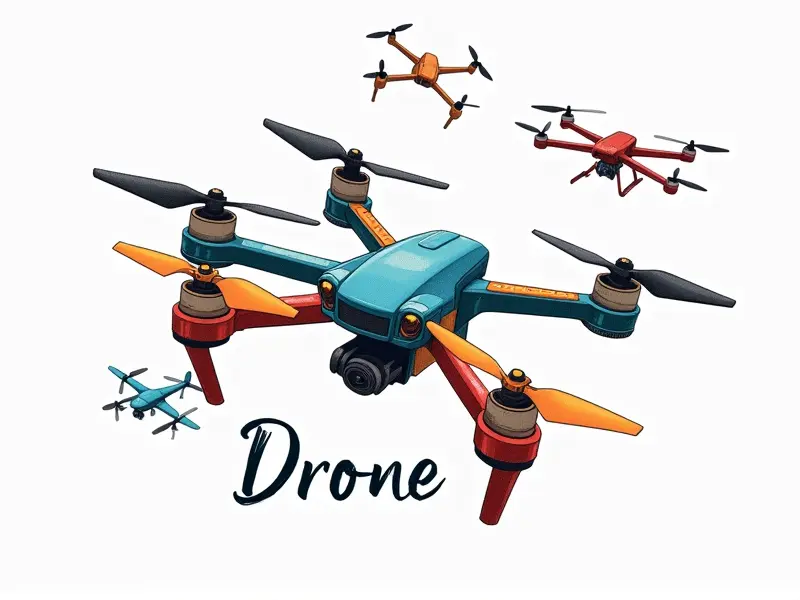Understanding propeller pitch

Understanding Propeller Pitch in RC Drones
In the world of remote-controlled (RC) drones and quadcopters, understanding propeller pitch is crucial for achieving optimal flight performance. This article delves into the intricacies of propeller pitch, explaining its significance and how it affects various aspects of drone operation.
What is Propeller Pitch in RC Drones?
The term "propeller pitch" refers to the angle at which a propeller blade cuts through the air. This angle determines how much thrust your drone generates as the blades rotate. A higher pitch means that each rotation of the propeller will push more air downwards, resulting in increased lift and speed.
Mastering Propeller Pitch for Optimal Flight
To master propeller pitch is to unlock the full potential of your RC quadcopter or drone. By selecting the right pitch, you can tailor your drone's performance to match specific flying conditions or personal preferences. Whether you're a hobbyist looking for stable flight or an FPV racer seeking top speeds, adjusting propeller pitch is key.
How Propeller Pitch Affects Drone Performance
The angle of the propeller blades significantly influences several aspects of drone performance:
- Lift and Thrust: Higher pitch provides more lift for climbing and maintaining altitude, but it also increases resistance.
- Speed: Lower pitch allows for faster horizontal movement without compromising stability.
Beginner's Guide to Propeller Pitch Adjustment
If you're new to RC drones, learning how to adjust propeller pitch is essential. Most drone props come with a range of standard pitches, but understanding the principles behind these settings can help you customize your setup:
- Identify Your Needs: Determine whether you prioritize altitude gain or speed.
- Select Appropriate Props: Choose propellers with the correct pitch for your drone's motor and frame configuration.
- Test Different Pitches: Experiment to find the optimal balance between lift, thrust, and stability.
Why Propeller Pitch Matters in FPV Racing
In first-person view (FPV) racing, every second counts. Propeller pitch plays a pivotal role in determining how fast your drone can accelerate and navigate tight corners:
- Enhanced Speed: Lower pitch enables quicker acceleration.
- Better Maneuverability: Adjusting pitch allows for precise control over turns and direction changes.
Propeller Pitch Explained: RC Quadcopter Basics
Understanding the basics of propeller pitch is fundamental to operating any RC quadcopter effectively. Here’s a breakdown of key concepts:
- Pitch Calculation: The angle at which each blade intersects with airflow, measured in inches or millimeters.
- Influence on Motor Load: Higher pitch increases the load on motors, impacting battery life and overall performance.
Maximizing Altitude Gain with Proper Pitch
To achieve optimal altitude gain, it's crucial to optimize propeller pitch. Here’s how:
- Choose Higher Pitches: For climbing and maintaining high altitudes.
- Balance Motor Power: Ensure your motor can handle the increased load without overheating.
Tuning Your Drone with the Right Prop Pitch
Tuning involves fine-tuning propeller pitch to suit specific flying styles or conditions. Here are steps to follow:
- Start With Standard Settings: Use manufacturer-recommended pitches as a baseline.
- Analyze Flight Data: Monitor performance and make adjustments based on real-world results.
- Iterate Until Optimal: Continuously tweak until you find the perfect balance for your needs.
The Impact of Propeller Pitch on Speed and Lift
The relationship between propeller pitch and speed is inversely proportional. As pitch increases, lift improves but horizontal speed decreases. Conversely, lower pitch enhances speed at the expense of reduced lift:
- Trade-offs: Balancing these factors requires careful consideration.
- Application-Specific Needs: Tailor your pitch according to intended use (racing vs. aerial photography).
Understanding Propeller Pitch: Key to Efficient Flight
Mastery of propeller pitch is the key to efficient and effective drone flight. By understanding how pitch affects performance, you can optimize your quadcopter for specific tasks or environments:
- Customization: Tailor your setup based on flying conditions.
- Performance Enhancement: Achieve better lift, speed, and stability.
Choosing the Right Propeller Pitch for You
Selecting the appropriate propeller pitch depends on your specific needs. Consider factors such as intended use (racing, photography, or general flying), frame design, motor specifications, and personal preferences:
- Research: Learn about different pitches and their effects.
- Experimentation: Test various setups to find the best fit.
Conclusion
Mastery of propeller pitch is essential for anyone serious about RC drones. Whether you're an FPV racer chasing top speeds or a hobbyist aiming for stable, efficient flight, understanding how pitch impacts performance can make all the difference. By carefully selecting and adjusting your propeller pitch, you unlock new levels of control and efficiency in the air.

